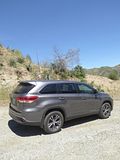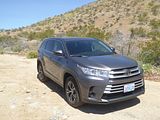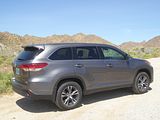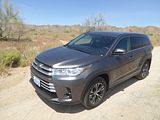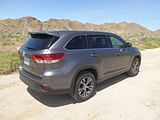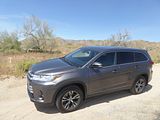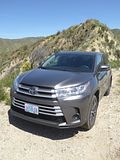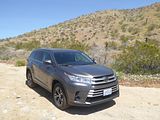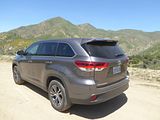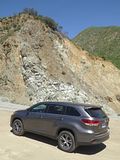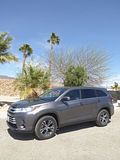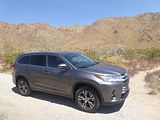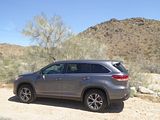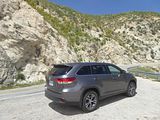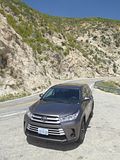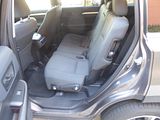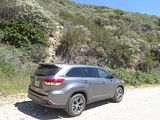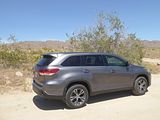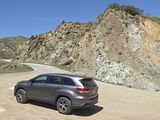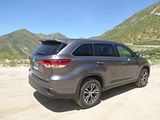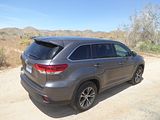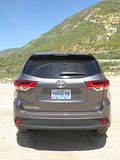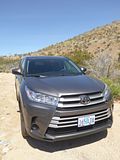Toyota sold no fewer than 244,511 examples of their Highlander model in the US last year, twice the figure that they achieved just five years ago, making it one of the best-selling Crossover vehicles on the US market, and with Camry sales taking a further dip, showing once again, how buyers are deserting the traditional saloon car in favour of this type of machine. The Highlander – known as the Kluger in Japan and Australia for trademark reasons – is now well into its third generation, as this version made its debut at the 2013 New York Auto Show, going on sale early in 2014. Each successive Highlander model has got physically larger, as the designers try to make more space for people and luggage in this three-row vehicle, even though on each occasion it actually uses the same underpinnings as the once sales-dominant Camry, which has not grown in the same way. The styling of the current Highlander does little to hide its bulk, and in fact the facelift that was applied in 2016, with a new grille being the obvious recognition point, did everything to try to make it look bigger than it is.
Although there were a few of these third generation Highlanders in the Hertz fleet soon after the vehicle went on sale, they never seemed to linger at the facility for long, and then I realised that they had all gone, just before the 2017 facelift. They staged a reappearance in 2018, though, with moderate numbers appearing at both Los Angeles and Phoenix airports, so I figured I should get the chance to sample one before the launch of the widely rumoured fourth generation model expected sometime later in 2019. That chance came on the final Saturday of my Spring 2019 trip, at LAX, when there was a surprisingly limited selection of cars on offer. Having wandered up and down the aisles a couple of times, trying to select something, I spotted this 2019 model, on Oregon plates still drying off in the morning sunshine, in the Gold area. I grabbed the keys before anyone else thought that this was a nice upgrade to claim for themselves.
As I was familiarising myself with the Highlander, I started to notice as much the things which were not there as those which were. Cloth seats are not an issue and indeed often preferable to leather, but they had to be adjusted manually, which was a bit of a surprise. At least the driver gets a height adjuster, but the front passenger does not. There is air conditioning, but it is not of the automated climate control variety, and whilst there is a small touch screen for the Entune infotainment system, it only offered AM/FM radio and a few screens for car set up and mileage and fuel consumption. You have to upgrade to a posher trim to get XM Satellite radio and navigation. The plastic moulded steering wheel felt like another meanness in a car of this class. Later research would suggest that this was indeed the LE trim, the very bottom of the range, with a low price tag that is designed to grab attention but which people are not supposed (or likely) to buy. Clearly the US motoring press have never seen one in bare bones spec like this, as their reviews, which seem generally to gush effusive praise on the whole vehicle, all refer to how nicely equipped and appointed it is and an “upscale” feel more befitting a luxury SUV. It felt like none of those things to me in this spec.
In fact, the test Highlander was not quite the price leader model, I thought, as the very entry level car comes not with the 3.5 litre V6 and AWD that was in the test car, but a rather weedy sounding 185 bhp 2.7 litre and front wheel drive. There are six trims: LE, LE Plus, XLE, SE, Limited, and Limited Platinum. Only the base LE is available with the four-cylinder unit, as all the other trims only come with the V6. There are few option packages or major standalone options, so you’ll likely have to upgrade to a higher trim if you want more features. Some a la carte upgrades include a rear-seat DVD/Blu-ray entertainment system and remote start. The base Highlander LE starts at $31,230, whereas the test car, with optional all-wheel-drive, and V6-power comes in from $34,740. Standard features include cloth seats, Bluetooth, five USB ports, voice recognition, a rearview camera, a 6.1-inch touch-screen infotainment system, forward collision warning, automatic emergency braking, pedestrian detection, lane departure warning, lane keep assist, automatic high beams, and adaptive cruise control. The Highlander LE Plus retails for $37,120 and comes with cloth and leatherette seats, a 10-way power-adjustable driver’s seat, a leather-trimmed steering wheel, tri-zone automatic climate control, satellite radio, HD Radio, smartphone-linked navigation, an 8-inch touch screen, and a power liftgate. The SE model is supposed to be the sporty offering, usually an oxymoron in Toyota’s range, and it boasts slightly altered styling and slightly firmer sports suspension. For $39,120, the Highlander XLE includes leather first- and second-row seats, leatherette third-row seats, heated front seats, second-row captain’s chairs, a moonroof, proximity key entry, push-button start, a 120-volt outlet, Driver Easy Speak, integrated navigation, the Entune app suite, blind spot monitoring, and rear cross traffic alert. The Highlander Limited costs $43,740 and comes with ventilated front seats, a four-way power-adjustable passenger seat, a 12-speaker JBL audio system, and rear parking sensors. The range-topping Highlander Limited Platinum will run you $46,860 and includes a panoramic moonroof, a heated steering wheel, heated second-row seats, front parking sensors, and a surround-view camera. Toyota have put quite an emphasis on safety features with this family-oriented machine. A standard pre-collision system includes forward collision warning, automatic emergency braking, and pedestrian detection. You’ll also get a standard rearview camera, lane-departure warning, lane keep assist, automatic high beams, and adaptive cruise control. Optional features include front and rear parking sensors, blind spot monitoring, rear cross traffic alert, and a surround-view monitor.
The Highlander has three rows of seats, though like most vehicles of this size and type, it you really want to get 8 people in, then at least some of them really need to be child size. The second row has ample space in it. The seats are on sliders, which come in handy not just for pulling them well forward to ease access to the third row, but also as there is plenty of legroom here so occupants may wish to sit a bit further forward to help out those in the back row. You can vary the position of the backrest, too, with a range of angles from pretty upright to quite laid back. The seats are split asymmetrically, so you can position them individually. Occupants here get a pull down armrest with cup holders in the upper surface, and there are air conditioning controls in the back of the centre console, along with USB sockets. Map pockets on the back of the front seats will be useful for odds and ends, along with bins on the doors. To get into the third row, you pull the second row backrests forward and the slide the whole seat as far forward as you can. There’s a reasonable amount of space to clamber through, though this is still a test of moderate athleticism and not one for those who wish to retain their elegant composure. Once installed, it would be pushing things to say that three adults could sit here, but three children would probably be OK, and they would find the legroom less of an issue. There are cupholders for occupants here, moulded into the sides and air vents are positioned on the roof. Headroom is not really the issue, but legroom and the fact that the seat is quite low so your knees would be in your chin probably would be.
Things are rather better for the front seat occupants. The manual adjustments on offer did allow me to get the seat where I wanted it relative to the dash and the pedals and the steering wheel had enough telescoping adjustment on it to give me a clear view of the instruments and to be in the right position for where my arms would naturally be. The front passenger does not get a height adjuster in this trim, but with plentiful headroom available, they are unlikely to find their head brushing the rooflining even if the seat is not at the height that they would have chosen. Upholstery was a sort of hard wearing cloth.
With all three rows of seats erect, luggage space is very limited indeed. The boot floor is very slightly higher than the bottom of the tailgate, so there is not a lot of depth and it is very short from back to front. Start folding down the seats, though, and you get a lot more space. With just the third row folded out of the way, there is plenty of space and the floor is flat. Fold away the middle row as well and there really is a lot of room. More than enough for most needs, I am sure. Inside the cabin, there is a decent glovebox, and there is a large and deep central cubby in the centre console, which has a small and a larger sliding lid to it. There are pockets on the doors and there is a slightly lipped but quite narrow stowage area on the dash that starts under the air conditioning controls and extends in front of the passenger. There is a small removable plug, which would allow you to poke cable through to the USB ports which are beneath this in an area in front of the gearlever.
The dash design of the Highlander is about as memorable as the rest of the car. Everything fits together well, and the plastics are mostly of a reasonable quality, and there was an odd burgundy coloured piece of leatherette on the door casings to provide a bit of variety beyond the chrome highlighter rings. There is a simple instrument cluster, with two large dials for speedo and rev counter and smaller ones for water temperature and fuel level. Between them is a display area and you can select from the menu options and sub options using a series of button-like touch pads on the right hand steering wheel spoke. Most of the trip mileage data is here, though if you want to see fuel consumption trends, this is in the central and larger screen. Column stalks are used for indicators and lights as well as the wipers and there is a smaller and stubbier one to the lower right of the wheel for cruise control. Audio repeaters are on the left hand steering wheel spoke. The centre of the dash contains the rather small 6.1″ touch screen for what limited infotainment functions are there. There are what look like buttons but which turn out to be touch pads on either side of it for a number of selections and there are conventional knobs for volume and radio tuning. The display looks very old generation, and the lack of functions in this LE trim were a disappointment. Beneath this you will find a row of knobs and buttons for the air conditioning system, with controls to set the separate zone for the rear as well as those in the front. Selecting AWD and disabling the traction control is done with a row of switches that are in a recess in front of the gearlever. A conventional, and very cheap feeling key is needed to start the Highlander.
And so we come to the driving experience, which is probably the least memorable thing about the car. The test vehicle had the optional 3.5 litre V6 unit, and all I can say is that anyone who selects the less potent 185 bhp four really can’t be in any form of a hurry, as even this 295 bhp V6 unit is not going to win any prizes for the performance it delivers. It is a smooth and refined engine, and noise levels emanating from it are very low indeed, but given that an engine is there to make a car go, you really would hope that this is what it would do. And here it struggles. Acceleration is very modest indeed unless you are quite brutal with the throttle pedal. Get the Highlander up to a steady cruise, and all is well, with road and wind noise also well suppressed, but even one up, it takes a while to get there. The 2016 facelift introduced an 8 speed gearbox to replace the former 6 speed unit, and it is seamless in is operation. There is a manual mode, but this is not the sort of car which encourages you to do anything more than go with the flow. I had the Highlander for two days, during which time I covered 458 miles and it consumed 17.5 gallons, meaning an average consumption of 26.17 mpg US or 31.4 mpg Imperial, a good result for a vehicle of this size, and likely a consequence of most of those miles being a long haul on the freeway to Joshua Tree and back.
It was the other dynamics that had me shaking my head in despair at the Highlander. The steering is the worst culprit. It is far too over-assisted, with absolutely no feel at all, among the very vaguest I have come across. Whilst that makes this relatively large machine quite easy to manoeuvre, it also meant that it needed constant corrections to try to keep it on course. And here is where one of its safety features, a Lane Keep Assist really annoyed me. It beeps every time it thinks you have crossed a line. Sometimes, it beeps when you definitely have not, and if you were in the inside lane of a freeway, an exit ramp was likely to generate a beep, but there were times up in the mountains when it did not trigger at all. If the steering is disappointing, so is the handling and grip. This is not a car for twisty roads, with terminal understeer evident from even quite modest speeds, something you just would not get in a Ford Explorer or Mazda CX-9. Toyota have concentrated instead on delivering a smooth ride, and in this regard they have succeeded, with the Highlander dealing with bumps and poor surfaces better than most. The brakes did not inspire me with a lot of confidence either. Although pedal efforts were modest and travel was progressive, nothing much seemed to happen and prudence required a longer stopping distance to allowed than you might expect. There is a foot operated parking brake. At least visibility was generally good. You did sit higher than in a regular saloon car, and the combination of plenty of glass area and a good field of view from the mirrors meant that I was well aware of what was around me. The reversing camera helped to judge where the back of the Highlander was.
This Highlander struck me in many ways as typical Toyota. It would doubtless be a faithful servant to its owner for many years, but it is not just utterly devoid of character, but it also feels like it is only as good as Toyota thought it needed to be to continue to get brand loyalists to continue buying it. It does have strengths, of course. It is quiet and refined, rides quite well, has a number of safety features included and is a spacious vehicle even if the third row of seats is only for children (but then this is the case for all its similarly sized rivals as well). But it is utterly soulless to drive, with that awful steering so completely devoid of feel making it quite a trial to keep pointing exactly where you want it to go, and when you don’t quite get it right – and even sometimes when you do – the irritating Lane Keep Assist will beep at you. It is a car for straight roads, for sure, as it is really not designed to cope with bends. The US press still seem to rate it highly, which is odd, as I thought that most of its rivals do pretty much everything that the Highlander does, and more, with some flair and in the case of a couple of them, being genuinely good to drive. A new model is rumoured to be in the wings. Let’s hope that rather than trying to make it more interesting by coming up with polarising styling, which is what Toyota have done rather a lot of in recent times, they actually make it a dynamically much better car. Until we find out if they do, I would recommend anyone looking for a vehicle in this category to go and seek out just about anything else.









